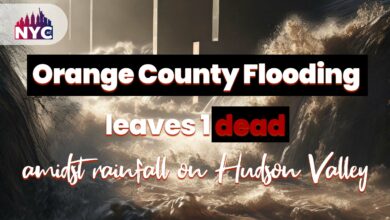
The weekend’s cool and wet weather will linger into Wednesday, accompanied by some gusty gusts. Though not a direct result of Hurricane Ian, which destroyed sections of Florida last week, weather analysts said tropical moisture carried up by the storm mingled with an area storm, creating sporadic rain in New York City and the neighboring areas of the United States.
“By mid-week, that implies more of the same thing for New York City, so we’re expecting rain waves,” meteorologist Garett Argianas told Gothamist. “It’s still quite windy.” I don’t believe the wind will be too bad here, although it will be breezy, maybe 30-35 mph.”
Weather Updates
Temperatures will be in the 50s tomorrow and between 50 and 60 degrees on Wednesday, which is very cool for October.
The rains on Monday also produced some coastal flooding. And Argianas predicted that there will be more of the same on Tuesday. The National Weather Service has issued a coastal flood warning for New York City and the surrounding area, which will be in effect until 6 p.m. Tuesday. According to Argianas, the impact has been minimal thus far, and similar conditions are expected on Tuesday.
“We’re expecting further coastal flooding on Tuesday afternoon,” Argianas warned. “It shouldn’t be anything major locally, but you could see flooding in certain parking lots or roadways near the water.”
October Rain
While rainy days might hamper certain outdoor activities, Argianas says it’s really a vital drink for the drought-stricken area.

“Although we have made progress here, we still need some additional rain by September and early October.” “We may call this helpful rain to close this deficit even further,” Argianas remarked.
No need to worry if you’re missing the sun. It returns in the second half of the week.
“I think Thursday will be a great October day, pleasant and sunny and back in the seventies,” Argianas said. “So, if you want to stay indoors and avoid going out in the windy, chilly, and wet weather, look forward to better weather in a few days.” [1]
What effect does climate change have on storms like Ian?
When scientists like Kevin Reed are questioned, they frequently respond negatively. Most scientists believe that pointing to a particular storm and claiming it was “caused” by global warming is not legitimate. There are too many variables.
“That is a really tough question to answer. There is no ‘what would September 2022 have looked like if climate change had not occurred?’ That is not available to us Reed is an associate professor in Stony Brook University’s school of marine and atmospheric sciences.
However, there is a growing understanding that sea level rise and rising temperatures over the previous century have already had an influence on hurricanes like Ian, which ravaged Florida last week and will continue to do so in the future. Hotter weather, at the very least, implies hotter waters, which feed storm power.
“We live in a world that is over 1 degree warmer (Celsius), and there is no question that storms have evolved in some way as a result of climate change,” he added.
Predictions
According to Tom Knutson, a senior scientist at NOAA who studies climate and hurricanes, experts are most confident in recognising how storms have altered in the contemporary era. But less so in terms of being able to link such changes to climate change. Predicting what the future may bring is much more difficult.

This is due to the complexity of storms and worldwide weather systems. Some of the changes in the climate and storms, for example, can be related to excessive amounts of physical air pollution sprayed into the atmosphere, in addition to greenhouse gases.
Storm-tracking technology has also advanced dramatically in recent decades. Scientists believe that we are now seeing many more “junk storms”—short-lived and feeble cyclones—than ever before. This can bias statistics, which is why most scientists are wary of establishing a direct correlation between a warming world and storm counts.
“It’s a complicated picture, and to add to it, we’re inferring many of these things from climate models, which are themselves dubious,” Knutson added. “We must exercise caution.”
Here’s where science stands on a few issues:
A higher storm surge is possible.
According to NOAA tidal gauge data, sea levels around South Florida have already risen roughly eight inches since 1950. This implies that the water begins at a higher base level, allowing hurricane surge to reach a few inches higher and cover more area.
Researchers predict that sea level rise will increase as temperatures rise and polar ice sheets melt more quicker. According to the UN Intergovernmental Panel on Climate Change, South Florida may expect more than three feet of sea level rise over the next century (IPCC). When storms hit coastal towns, storm surges will rise as a result.
It’s hardly surprising, therefore, that one research of the 2020 hurricane season discovered an average 8% increase in 3-day rainfall totals for hurricanes and a 5% increase for tropical moisture .
Analysis
According to the primary author, Stony Brook’s Reed, a hotter planet increases the rate of rainfall. Three-hour rainfall rates for tropical moisture and hurricanes would climb by 10% or more in the 2020 season.
“If you get a comparable storm in the future, it will rain more due of climate change,” he said. “If you received 30 inches of rain, you might claim that more than 2.5 inches of that rain was attributable to climate change, which means that it would not have rained as much if we hadn’t heated the earth.“
On Thursday, Reed and his colleagues published a fast assessment of Hurricane Ian that revealed a 10% rise in high rain rates owing to human-caused climate change.
This field of study, known as attribution science, seeks to address the issue of how climate change affected a specific storm. In Reed’s case, he and his colleagues feed a sophisticated supercomputer NYC weather model the precise trajectory and data from a modern-day storm, then reset the clock to the 1850s temperature and atmospheric conditions.
The most noticeable difference they see is that storms are significantly less moist than in the past.
Increasing strength more quickly
Rapid intensification, which occurs when a storm’s highest wind speeds rise by 35 mph or more in a single day, is one of the most destructive characteristics of hurricanes. It’s also difficult to anticipate, so when a storm strengthens abruptly along the coast, coastal people have little time to prepare or flee.

According to preliminary research, climate change has already made fast intensification more prevalent. According to a 2021 IPCC study, “the worldwide frequency of [tropical moisture cyclone] fast intensification episodes has likely risen over the last four decades,” and researchers have “medium confidence” that “none of these trends can be explained solely by natural variability.”
Researchers may now claim with greater certainty that the circumstances that cause fast escalation are becoming increasingly widespread. According to NOAA, sea surface temperatures are rising at a pace of 0.14 degrees Fahrenheit every decade, while atmospheric moisture is growing at a rate of one to two percent per decade. Both of these characteristics may provide future hurricanes with more fuel to accelerate their growth.
Meanwhile, NOAA and Columbia University scientists expect that climate change would diminish vertical wind shear, an atmospheric phenomenon that can slow down fast intensification.
“We’ve seen numerous studies that demonstrate the circumstances in the North Atlantic basin are offering greater potential for storms to strengthen,” said Kieran Bhatia, a former Princeton University climate researcher who is now with the National Weather Service in New York.
Fewer but stronger Hurricanes
Climate warming may cause hurricanes to become more violent but fewer frequent.
Reliable worldwide records of hurricane intensity date back just roughly four decades, when meteorological satellites enabled scientists to precisely assess storm power. Hurricanes appear to be increasing stronger in the years since, according to a 2020 article from NOAA and the University of Wisconsin researchers. They discovered that the risk of a cyclone reaching Category 3 wind speeds—the threshold for being classified as a “major hurricane”—has increased by around 25% since 1979, as more heat in the seas and atmosphere provides storms with more fuel to expand.
Hurricanes may become less common as a result. According to a July research published in Nature Climate Change, tropical moisture cyclones generated 13% less frequently in the twentieth century than they did between 1850 and 1900. Although hurricane data prior to the satellite era is limited, a multinational team of researchers filled in the gaps by combining real-world observations with simulations from climate models to estimate the number of storms that may have formed between 1850 and 2012.
“A series of consecutive seasons with Category 5s is more consistent with what we’d expect in a warmer climate… rather than a greater number of storms,” said Brian Soden, an atmospheric sciences professor at the University of Miami’s Rosenstiel School of Marine and Atmospheric Science.
Slower and wetter storms
Jim Kosin, a climate scientist at the NOAA Cooperative Institute for Meteorological Satellite Studies in Madison, Wisconsin, released a report in 2018 claiming that tropical moisture and hurricanes worldwide slowed by 10% between 1949 and 2016, and slowed even more over land.
It drew some criticism from the scientific community, but he followed it up in 2019 with another study paper co-authored with NASA’s Timothy Hall that focused on the slowing of storms along the North American coast since 1950.
They discovered that the forward speed of hurricanes has reduced since 1900, which might result in even more rainfall and floods if a storm stalls over land. More research is needed to establish how much more slowdown will occur as the planet continues to warm. “However, it’s absolutely possible that this slowdown, rather than the predicted rain-rate increases due to global warming, may dominate local rainfall increases,” Kossin said on an NOAA blog[2].
NOAA’s Knutson described it as “the most persuasive indication of a trend I’ve seen so far.”
However, he stressed that just because a pattern was found does not always imply that climate change is to blame. “That is a research question.”
More landfalls may be in future
Many storms at sea were previously unnoticed until reported by vessels unlucky enough to encounter them. On those that make it to shore, though, solid records stretch back a century or more.
Knutson’s new research, which is based on entering previous data into a computer model, predicts what will happen to storm routes in the future if global warming continues unabated. He discovered that, while the number of storms making landfall hasn’t increased significantly over the previous century, a growing percentage may in the future.
When combined with recent data indicating that fewer but more severe storms may emerge in the future, Knutson believes cities may face fewer but more violent strikes. “It’s a bunch of effects cutting in different ways,” he explained. Knutson, being the cautious scientist, stressed that his study was simply a forecast.
“That is part of the model. We’ll have to wait and watch what occurs in the real world “He stated.
Here’s what to know about Ian.
Flooding and water consumption worries remained Sunday in portions of Florida, where officials say more than 80 people died as a result of Hurricane Ian. As rescue efforts in some of Florida’s hardest-hit coastal communities continued, Ian’s leftovers headed northeast into Virginia as a weakened storm, bringing rain and the threat of localized flooding to sections of the Mid-Atlantic[3].
Latest developments:
- According to quickly shifting official and local statistics, more than 80 people died in Florida as a result of the hurricane, including 42 in Lee County on the state’s southwest coast. Governor Roy Cooper says four individuals died in storm-related incidents in North Carolina.
- On Sunday, residents of St. Cloud, Fla., were advised to evacuate due to rising floods. Officials reported significant water levels in parts of that area that had never previously flooded.
- Residents in Orlando, where Ian damaged the sewage infrastructure, were encouraged to conserve water.
- President Biden and First Lady Jill Biden will visit Puerto Rico this week to assess the devastation caused by Hurricane Fiona two weeks ago. They will next travel to Florida to examine recovery operations following Hurricane Irma.
References
https://gothamist.com/news/cold-rainy-weather-will-stick-around-thanks-to-tropical-moisture-brought-by-hurricane-ian
[2] Alex Harris and Nicolas Rivero, Climate change impacts hurricanes like Ian (October,3,2022), by Phys.org[https://wusfnews.wusf.usf.edu/environment/2022-10-07/how-climate-change-impacts-hurricanes-like-ian]
[3] Hilary Swift, (October 2022) Storm Updates: Death Toll Rises as Rescuers Search for Hurricane Ian Survivors, by New York Times[https://www.nytimes.com/live/2022/10/02/us/hurricane-ian-florida-south-carolina]



